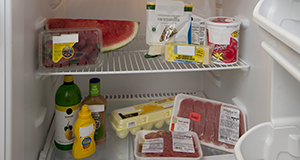Abstract
The bacterium Clostridium perfringens causes one of the most common types of foodborne gastroenteritis in the United States, often referred to as perfringens food poisoning (FDA 2012). It is associated with consuming contaminated food that contains great numbers of vegetative cells and spores that will produce toxin inside the intestine. There are two forms of disease caused by C. perfringens: gastroenteritis and necrotizing enteritis. The latter disease, also known as pig-bel disease, is not common in the United States. It is often associated with contaminated pork and can be very severe (FDA 2012).
References
Birkhead, G., R. L. Vogt, E. M. Heun, J. T. Snyder, and B. A. McClane. 1988. “Characterization of an Outbreak of Clostridium perfringens Food Poisoning by Quantitative Fecal Culture and Fecal Enterotoxin Measurement.” Journal of Clinical Microbiology 26 (3): 471–474. https://doi.org/10.1128/jcm.26.3.471-474.1988
Centers for Disease Control and Prevention (CDC). 2024a. “About C. perfringens Food Poisoning.” Accessed November 13, 2024. https://www.cdc.gov/clostridium-perfringens/about/index.html
Centers for Disease Control and Prevention (CDC). 2024b. “BEAM (Bacteria, Enterics, Ameba, and Mycotics) Dashboard.” National Center for Emerging Zoonotic Infectious Diseases (NCEZID). Accessed November 13, 2024. https://www.cdc.gov/ncezid/dfwed/BEAM-dashboard.html
Cornell University College of Agriculture and Life Sciences (Cornell CALS). n.d. “Bacterial Endospores.” Microbiology. Accessed November 13, 2024. https://cals.cornell.edu/microbiology/research/active-research-labs/angert-lab/epulopiscium/bacterial-endospores
Dailey, N. J., N. Lee, A. T. Feischauer, Z. S. Moore, E. Alfano-Sobsey, F. Breedlove, A. Pierce, et al. 2012. “Clostridium perfringens Infections Initially Attributed to Norovirus, North Carolina, 2010.” Clinical Infectious Diseases 55 (4): 568–570. https://doi.org/10.1093/cid/cis441
Food and Drug Administration (FDA). 2012. “Clostridium perfringens.” Bad Bug Book: Foodborne Pathogenic Microorganisms and Natural Toxins Handbook. https://www.fda.gov/media/83271/download
Food and Drug Administration (FDA). 2017. Food Code. US Public Health Service. https://www.fda.gov/media/110822/download
Grass, J. E., L. H. Gould, and B. E. Mahon. 2013. “Epidemiology of Foodborne Disease Outbreaks Caused by Clostridium perfringens, United States, 1998–2010.” Foodborne Pathogens and Disease 10 (2): 131–135. https://doi.org/10.1089/fpd.2012.1316
Gui, L., C. Subramony, J. Fratkin, and M. D. Hughson. 2002. “Fatal Enteritis Necroticans (Pigbel) in a Diabetic Adult.” Modern Pathology 15 (1): 66–70. https://doi.org/10.1038/modpathol.3880491
Petrillo, T. M., B. M. Consuelo, J. G. Songer, C. Abramowsky, J. D. Fortenberry, L. Meacham, A. G. Dean, H. Lee, D.M. Bueschel, and S. R. Nesheim. 2000. “Enteritis Necroticans (Pigbel) in a Diabetic Child.” The New England Journal of Medicine 342 (17): 1250–1253. https://doi.org/10.1056/NEJM200004273421704
Scallan, E., R. M. Hoekstra, F. J. Angulo, R. V. Tauxe, M. -A. Widdowson, S. L. Roy, J. L. Jones, and P. M. Griffin. 2011. “Foodborne Illness Acquired in the United States—Major Pathogens.” Emerging Infectious Diseases 17 (1): 7–15. https://doi.org/10.3201/eid1701.P11101
Scharff, R. L. 2011. “Economic Burden from Health Losses Due to Foodborne Illness in the United States.” Journal of Food Protection 75 (1): 123–131. https://www.sciencedirect.com/science/article/pii/S0362028X2300426X
Songer, J. G. 2010. “Clostridia as Agents of Zoonotic Disease.” Veterinary Microbiology 140 (3–4): 399–404. https://doi.org/10.1016/j.vetmic.2009.07.003

This work is licensed under a Creative Commons Attribution-NonCommercial-NoDerivatives 4.0 International License.
Copyright (c) 2024 UF/IFAS

